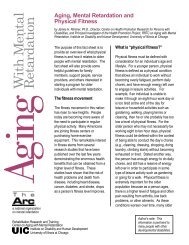Bridging the Aging and Developmental Disabilities Service ... - rrtcadd
Bridging the Aging and Developmental Disabilities Service ... - rrtcadd
Bridging the Aging and Developmental Disabilities Service ... - rrtcadd
Create successful ePaper yourself
Turn your PDF publications into a flip-book with our unique Google optimized e-Paper software.
Community First Choice Option. An important provision of <strong>the</strong> ACA is <strong>the</strong> Medicaid<br />
Community First Choice Option, also known as <strong>the</strong> HCBS Attendant <strong>Service</strong> Option. Effective<br />
October 1, 2011 states were able to provide person-centered attendant services <strong>and</strong> supports<br />
under <strong>the</strong>ir state Medicaid plan to assist individuals with <strong>the</strong>ir activities of daily living,<br />
instrumental activities of daily living, <strong>and</strong> health-related tasks. States can also cover costs of<br />
moving individuals from institutions to <strong>the</strong> community. States that participate in this program<br />
receive a 6% increase in <strong>the</strong>ir federal match rate for <strong>the</strong>se services. 34<br />
Money Follows <strong>the</strong> Person. The Money Follows <strong>the</strong> Person demonstration program created by<br />
<strong>the</strong> Federal Deficit Reduction Act of 2005 gives people residing in state institutions <strong>and</strong> nursing<br />
homes <strong>the</strong> option to live in <strong>the</strong> community. States that participate in <strong>the</strong> program must use <strong>the</strong><br />
increased FMAP <strong>the</strong>y receive to exp<strong>and</strong> long-term community services <strong>and</strong> supports. The 29<br />
states <strong>and</strong> <strong>the</strong> District of Columbia that were funded in 2007 transitioned 11,924 people to <strong>the</strong><br />
community by December 31, 2010, including 3,100 individuals with intellectual <strong>and</strong><br />
developmental disabilities. 35 The ACA extends Money Follows <strong>the</strong> Person through 2016 <strong>and</strong><br />
reduces <strong>the</strong> minimum institutional length of stay to participate from six months to 90 days. In<br />
2011, an additional 13 states received grants to initiate Money Follows <strong>the</strong> Person demonstration<br />
projects. As of August, 2011, nearly 17,000 persons had transitioned back to <strong>the</strong> community <strong>and</strong><br />
ano<strong>the</strong>r 5,700 transitions were in progress. 36<br />
Health Home Model for Medicaid Beneficiaries with Multiple Chronic Conditions. The ACA<br />
permits states to amend <strong>the</strong>ir state Medicaid plan to fund medical home services to people with<br />
multiple chronic conditions including mental illness, substance use disorder, asthma, diabetes,<br />
heart disease, <strong>and</strong> being overweight per a body mass index of over 25. Participant eligibility is<br />
based on having at least two of <strong>the</strong>se conditions, one chronic condition <strong>and</strong> being at risk for<br />
ano<strong>the</strong>r, or having one serious <strong>and</strong> persistent mental health condition. States have flexibility in<br />
which conditions <strong>the</strong>y want to target, but include all categorically needy individuals <strong>and</strong><br />
individuals who are dually eligible for Medicare <strong>and</strong> Medicaid. Health homes provide <strong>the</strong><br />
medical, behavior health, <strong>and</strong> social services <strong>and</strong> supports <strong>the</strong> individual needs based on <strong>the</strong>ir<br />
chronic conditions. This provision went into effect in January 2011 <strong>and</strong> raises <strong>the</strong> federal<br />
matching rate to 90% for two years for states choosing <strong>the</strong> health home option. 36<br />
Medicaid Managed (Integrated) Care<br />
States began to establish managed care plans for health care <strong>and</strong> long term supports for targeted<br />
groups of Medicaid beneficiaries, including developmental disabilities, in <strong>the</strong> 1980s to contain<br />
escalating program costs. Managed care plans can be implemented by amending <strong>the</strong> state<br />
Medicaid plan or under a Medicaid waiver. Waiver plans allow states to enroll people who are<br />
dually eligible for Medicare <strong>and</strong> Medicaid. In 2010, 47 states <strong>and</strong> <strong>the</strong> District of Columbia had<br />
established Medicaid managed care plans that in aggregate served 71% of <strong>the</strong> total Medicaid<br />
population. 37 States use two basic models including various hybrids to finance <strong>and</strong> administer<br />
<strong>the</strong>ir managed care programs. 38<br />
<strong>Bridging</strong> <strong>the</strong> <strong>Aging</strong> <strong>and</strong> <strong>Developmental</strong> <strong>Disabilities</strong> <strong>Service</strong> Networks Page 26



